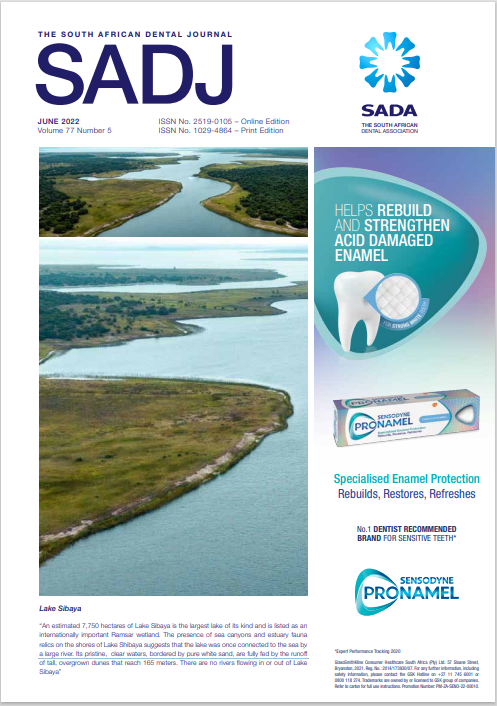Buccal corridor changes in orthodontically treated extraction and non-extraction Class 1 patients
DOI:
https://doi.org/10.17159/2519-0105/2022/v77no5a1Keywords:
Buccal corridors changes, extraction, nonextraction, visible maxillary dentition, oral apertureAbstract
Patients seek orthodontic treatment mainly to improve their facial aesthetics and obtain an acceptable smile. It is purported that orthodontic extraction treatment may result in narrow buccal corridors which in turn may lead to unaesthetic smile. To determine if the dimensions of the buccal corridors are influenced by extraction or non-extraction treatment in Class 1 patients. Retrospective record-based study conducted between 2012 and 2017 at University of Pretoria Orthodontic department. Smile pictures of pre- and post-treatment Class 1 patients treated with or without premolar extractions were matched. Buccal corridors between the two groups were measured by measurement of visible maxillary dentition and oral aperture dimensions. Data analysis included frequencies
and correlations using chi-square test, with a significance level set at p<0.05. Seventy-one patient records met the selection criteria with the majority being females (70%). The age range was between 10 and 37 with a mean of 17.5 years. Thirty-five patients were treated with extractions and thirty-six patients with non-extraction treatment. There was a significant difference in the visible maxillary dentition pre and post treatment with extraction patients showing a 6 to 6 and non-extraction showing 5 to 5 dentition post treatment
(p<0.05). There were no differences in the ratios of the visible maxillary dentition and oral aperture in both groups pre and post treatment (p> 0.05). Orthodontic treatment of Class 1 cases with premolar extraction did not lead to deleterious changes in the buccal
corridors.
Downloads
References
Goldstein R. Study of the need for easthetics in dentistry. J Prost Dent. 1969;21(6):589 - 98.
Abu Alhaija ESJ, Al-Shamsi NO, Al-Khateeb S. Perceptions of Jordanian laypersons and dental professionals to altered smile aesthetics. Eur J Orthod. 2011;33(4):450-6
Sharma PK, Sharma P. Dental Smile Esthetics: The Assessment and Creation of the Ideal Smile. Semin Orthod. 2012;18(3):193-201.
Frush JP, Fisher RD. The dynesthetic interpretation of the dentogenic concept. J Prosthet Dent. 1958;8(4):558-8.
Hulsey CM. An esthetic evaluation of lip-teeth relationships present in the smile. Am J Orthod. 1970;57(2):132-44.
Roden-Johnson Dustin, Gallerano Ronald, Jeryl E. The effects of buccal corridor spaces and arch form on smile esthetics. Am J OrthodDentofacial Orthop. 2005;127(3):343-50
Sarver DM, Ackerman MB. Dynamic smile visualization and quantification: part 2. smile analysis and treatment strategies. Am J Orthod Dentofacial Orthop. 2003;124(2):116-27.
Andrews LF. The six keys to normal occlusion. Am J Orthod Dentofacial Orthop. 1972;62(3):296-309.
Xu H, Han X, Wang Y, Shu R, Jing Y, Tian Y, et al. Effect of buccolingual inclinations of maxillary canines and premolars on perceived smile attractiveness. Am J Orthod Dentofacial Orthop. 2015;147(2):182-9.
Meyer AH, Woods MG, Manton DJ. Maxillary arch width and buccal corridor changes with orthodontic treatment. Part 2: attractiveness of the frontal facial smile in extraction and nonextraction outcomes. American journal of orthodontics and dentofacial orthopedics :
official publication of the AAO, its constituent societies, and the ABO. 2014;145(3):296-30.
Kim E, Gianelly AA. Extraction vs NonextractionArch Widths and Smile Esthetics. Angle Orthod. 2003;73(4):354-8.
Dong JK, Jin TH, Cho HW, Oh SC. The esthetics of the smile: a review of some recent studies. Int J 16239 Pronamel Strip ad PRESS.indd 1 2021/03/12 15:29262 > RESEARCH www.sada.co.za / SADJ Vol. 77 No. 5Prosthodont. 1999;12(1):9-19.
Luppanapornlarp S, Johnston LE Jr. The Effects of Premolar-extraction: A Long-term Comparison of Outcomes in “Clear-cut” Extraction and Non-extraction Class II Patients. The Angle Orthod. 1993;63(4):257-72
Nascimento DC, Santos ÊRd, Machado AWL, Bittencourt MAV. Influence of buccal corridor dimension on smile esthetics. Dental Press J Orthod. 2012;17(5):145-50
Martin AJ, Buschang PH, Boley JC, Taylor RW, McKinney TW. The impact of buccal corridors on smile attractiveness. Eur J Orthod. 2007;29(5):530-7.
Germec-Cakan D, Taner TU, Akan S. Arch-width and perimeter changes in patients with borderline Class I malocclusion treated with extractions or without extractions with air-rotor stripping. Am J Orthod Dentofacial Orthop. 2010;137(6):734-5.
Meyer AH, Woods MG, Manton DJ. Maxillary arch width and buccal corridor changes with orthodontic treatment. Part 1: Differences between premolar extraction and nonextraction treatment outcomes. Am J Orthod Dentofacial Orthop. 2014;145(2):207-16
Johnson DK, Smith RJ. Smile estheties after orthodontic treatment with and without extraction of four first premolars. Am J Orthod Dentofacial Orthop. 1995;108(2):162-7.
Moore T, Southard KA, Casko JS, Qian F, Southard TE. Buccal corridors and smile esthetics. Am J Orthod Dentofacial Orthop.2005;127(2) :208-13.
Wylie W. The Mandibular Incisor: Its Role in Facial Aesthetics. Angle Orthod. 1955;25(1) :32-41: 32-41
Downloads
Published
Issue
Section
License

This work is licensed under a Creative Commons Attribution-NonCommercial 4.0 International License.





.png)